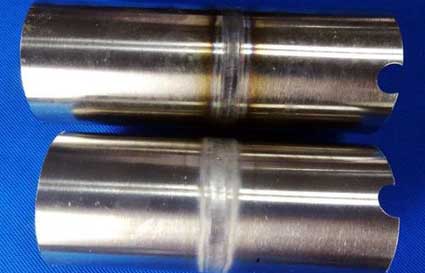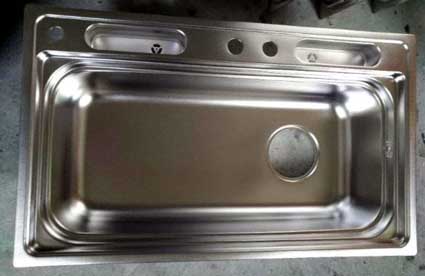Necessity of Environmental Protection Passivation for Surface Treatment of Stainless Steel Parts
Key words: stainless steel parts, stainless steel surface treatment, stainless steel passivation treatment
Stainless steel is a steel that does not rust. Stainless Steel is the abbreviation of stainless acid-resistant steel. It is resistant to air, steam, water and other weak corrosive media or stainless steel called stainless steel. Commonly used stainless steels are mainly martensitic steel, ferritic steel, austenitic steel, austenitic-ferritic (duplex) stainless steel and precipitation hardened stainless steel. Common models: SUS201, SUS304, SUS303, SUS420, SUS430, etc.

Stainless steel parts are transported, scribed, blanked and welded during the manufacturing process. As long as each process is slightly careless, there will be scratches, scratches, hammer marks and so on on on the surface of spare parts. Reduce the corrosion resistance of components and directly affect the service life. Therefore, there is often a stainless steel processing manufacturer that encounters a stainless steel component after processing or a corrosion resistance test for the product, "Salt Fog Test" is very low. It can not meet the quality requirements of customers, and even has not been tested and stored, which is very easy to rust problems and phenomena. In order to improve the corrosion resistance of stainless steel parts and prolong the service life of the products, stainless steel parts must be subjected to stainless steel passivation surface treatment.

The stainless steel surface passivation process is as follows:
1. Pretreatment of stainless steel surface:
a, stainless steel surface has weld oxide, welding spatter must be removed.
b, The surface of the stainless steel is oily and must be cleaned.
2, stainless steel surface passivation treatment process:
Pretreatment → passivation (according to the process) → rinse (cold water or hot water rinse) → neutralization → drying treatment.
The passivation time should be performed as specified, no advance is allowed, and no delay is allowed.
3. Quality inspection:
When asked to check with the blue dot method, proceed as follows. The solution is prepared by using 1 gram of red blood salt + 3 ml of 65-85% HNO3 + 100 ml of water, impregnating the solution with filter paper, and attaching it to the surface to be inspected. It is also possible to directly apply the solution to the surface to be inspected, such as a surface passivation film which is imperfect or has iron ion contamination, that is, blue. If there is no blue dot within 1 minute, it is considered qualified. Neutral salt spray test This is a relatively common detection method with high accuracy.

Stainless steel is a steel that does not rust. Stainless Steel is the abbreviation of stainless acid-resistant steel. It is resistant to air, steam, water and other weak corrosive media or stainless steel called stainless steel. Commonly used stainless steels are mainly martensitic steel, ferritic steel, austenitic steel, austenitic-ferritic (duplex) stainless steel and precipitation hardened stainless steel. Common models: SUS201, SUS304, SUS303, SUS420, SUS430, etc.

Stainless steel parts are transported, scribed, blanked and welded during the manufacturing process. As long as each process is slightly careless, there will be scratches, scratches, hammer marks and so on on on the surface of spare parts. Reduce the corrosion resistance of components and directly affect the service life. Therefore, there is often a stainless steel processing manufacturer that encounters a stainless steel component after processing or a corrosion resistance test for the product, "Salt Fog Test" is very low. It can not meet the quality requirements of customers, and even has not been tested and stored, which is very easy to rust problems and phenomena. In order to improve the corrosion resistance of stainless steel parts and prolong the service life of the products, stainless steel parts must be subjected to stainless steel passivation surface treatment.

The stainless steel surface passivation process is as follows:
1. Pretreatment of stainless steel surface:
a, stainless steel surface has weld oxide, welding spatter must be removed.
b, The surface of the stainless steel is oily and must be cleaned.
2, stainless steel surface passivation treatment process:
Pretreatment → passivation (according to the process) → rinse (cold water or hot water rinse) → neutralization → drying treatment.
The passivation time should be performed as specified, no advance is allowed, and no delay is allowed.
3. Quality inspection:
When asked to check with the blue dot method, proceed as follows. The solution is prepared by using 1 gram of red blood salt + 3 ml of 65-85% HNO3 + 100 ml of water, impregnating the solution with filter paper, and attaching it to the surface to be inspected. It is also possible to directly apply the solution to the surface to be inspected, such as a surface passivation film which is imperfect or has iron ion contamination, that is, blue. If there is no blue dot within 1 minute, it is considered qualified. Neutral salt spray test This is a relatively common detection method with high accuracy.






